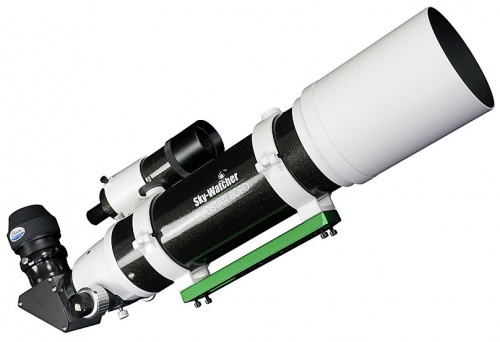Everyone’s classic idea of a telescope, a series of at least two lenses to magnify and bring into focus an image. As used by Galileo but invented by Dutch eyeglass maker Hans Lippershey.
For a complete discussion on choosing a telescope see Chapter 6 of the Deep Sky Imaging Primer by Charles Bracken.
At modest focal lengths, refractors offer the best imaging quality at a reasonable price.
Different wavelengths refract by differing amounts so unless corrected these telescopes suffer from chromatic aberration. This shows up as a rainbow effect at the edges of images.
Very good correction can be achieved by doublet achromats which have two lenses one of which is ED (Extra-low Dispersion) glass. Apochromats use three lens elements to bring three wavelengths to focus and true apochromats exhibit no false colour. However, there is more to telescope design than the number of elements and the quality of glass. A well-designed doublet ED scope can be better than a poor triplet. As the focal length of these scopes increases they become increasingly heavy and expensive.
Here are selection of refractors suitable for imaging arranged by increasing price.
Sky-Watcher Evostar 80ED

A modest priced doublet achromat. One element is made from premium Japanese Ohara FPL-53 Extra-Low Dispersion (ED) glass, which virtually eliminates chromatic aberration. This scope has a reputation for “punching above its weight” and offering better quality images than some more expensive scopes of a higher specification. Focal Length of 600 mm (f/7.5) and often recomended as the ideal first serious scope.
#
Explore Scientific ED APO 102mm f/6.7 Essential

An affordable triplet with a slightly longer reach. This is the no nonsense version of the ES102 with very good Hoya FCD001 ED glass; has two air spaces and provides a level of correction superior to the two-lens constructions, It comes with no eyepieces or other accesories and this is reflected in the price. Higher spec versions of this scope are also available. However if you are imaging in suburban skies with average seeing, a higher spec may not translate into better images. weight: 4,9kg. Focal Length 714mm
Focal Ratio f/7